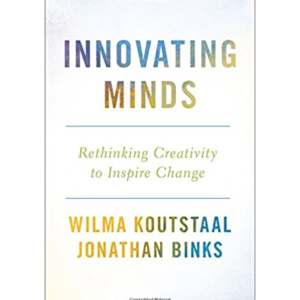 How can creativity and innovation give rise to positive changes in ourselves and the world around us? Wilma Koutstaal, University of Minnesota Professor of Psychology, and Jonathan Binks, who runs the organization InnovatingMinds4Change, tackle this challenging question in their book Innovating Minds: Rethinking Creativity to Inspire Change. They offer a framework of five key questions to consider in undertaking endeavors that call for creativity. First, we should identify the ideas that capture our attention and consider how we shape those ideas. To see a problem differently, we should consider changing the level of abstraction with which we think about it. We should allow spontaneity and deliberateness to be part of the creative process. The authors encourage us to recognize the role of emotions, motivations, and perceptions in our creative endeavors. Finally, we should consider how our physical, symbolic, and social spaces and tools impact our ability to demonstrate creativity. Koutstaal and Binks conclude each chapter with stimulating questions to challenge their readers to think about how their habits impact their creativity. This book will provide help to the creative individual seeking to accelerate her work, as well as to the leader of an organization wishing to bring about change.
How can creativity and innovation give rise to positive changes in ourselves and the world around us? Wilma Koutstaal, University of Minnesota Professor of Psychology, and Jonathan Binks, who runs the organization InnovatingMinds4Change, tackle this challenging question in their book Innovating Minds: Rethinking Creativity to Inspire Change. They offer a framework of five key questions to consider in undertaking endeavors that call for creativity. First, we should identify the ideas that capture our attention and consider how we shape those ideas. To see a problem differently, we should consider changing the level of abstraction with which we think about it. We should allow spontaneity and deliberateness to be part of the creative process. The authors encourage us to recognize the role of emotions, motivations, and perceptions in our creative endeavors. Finally, we should consider how our physical, symbolic, and social spaces and tools impact our ability to demonstrate creativity. Koutstaal and Binks conclude each chapter with stimulating questions to challenge their readers to think about how their habits impact their creativity. This book will provide help to the creative individual seeking to accelerate her work, as well as to the leader of an organization wishing to bring about change.
Our ideas come about from cyclical interactions among our minds, brains, and environments. Thinking occurs in our minds, supported by our brains. Our brains integrate signals from our bodies, and our bodies are continually exploring our environment. Depending on these interactions, different ideas can come to mind with differing levels of ease or challenge. To generate new and creative ideas it can be helpful to allow our thinking to oscillate between “zooming in” and “zooming out.” Changing levels of abstraction can help us reason by analogy, reduce our working memory load to create more space to think openly, and diminish our tendency to see objects in terms of only their intended use rather than in terms of all their possible uses.
Several distributed networks in the brain work together to orchestrate our creative thinking. The executive control network helps us plan, pay attention, and monitor progress towards a goal. The default mode network is important for imagining, thinking about the future, and taking others’ perspectives. The salience network helps us detect information in our environment, integrate information that is important to us, and switch between the utilization of other networks in the brain. Koutstaal and Binks explain that the brain’s prefrontal cortex is important for abstract thinking. They also explain the role of dopamine, a neurochemical, in producing cognitive stability and flexibility and in seeking new experiences, which can prompt creativity.
Either by our own violation or because of factors in our environment, our focus can shift from being pointed and deliberate to being expansive and free-flowing. The creative process necessitates both deliberate and spontaneous thoughts. Reducing our intense, pointed attention or allowing our minds to wander can foster creativity by making space for a greater variety of stimuli in the environment to enter our awareness. This, in turn, can shape the way we think about a challenge and impact our ability to notice opportunities to fill a need. On the other hand, intense focus and control allow us to persist through obstacles to achieve a creative goal.
The authors identify several factors that can boost creativity. A few of the examples the authors offer include: instructing people to think differently, having practiced and prepared for the demands of a creative task, explaining creative ideas to others to prompt shifting levels of abstraction, minimizing distractions to allow for a state of flow, adding and removing constraints within a creative problem, improvising, and thinking about the future without losing sight of the present.
Change begets change. More experience can foster more creativity. When teams or organizations seek to change or innovate, both the individual members of the group and the group as a whole impact the group’s adaptability. Teams that are more receptive to novelty, more emotionally stable, and more reflective about their practices are better able to change. Optimism is beneficial in promoting creativity, but it must be paired also with the ability to critique and be skeptical from time to time.
Ultimately, Koutstaal and Binks suggest identifying meaningful goals, finding synergy among one’s goals, being driven by one’s goals while remaining open to change in light of new information, modulating the extent to which our goals come to mind when we need them, and modifying our goals when needed. Because of the insights in this book into the innovation process and the examples of successful creative individuals and teams, Innovating Minds is likely to advance the way any reader thinks about the creative change process.
Koutstaal, W., & Binks, J. (2015). Innovating Minds: Rethinking Creativity to Inspire Change. New York: Oxford University Press.




The brain loves humor, novelty and good old Kartoon Kar Krashes! Everything can be pictured and encoded WITH SOUND EFFECTS. Thus you use much larger portions of the brain – musical, audio, video to encode in the first place. This makes retrieval much easier because of all of the cross referenced Cartoon Condos in which you put the information. Then get plenty of sleep BECAAAUSE because when you’re sleeping the brain “takes out the garbage and the trash, and leaves more room for your learning stash.”